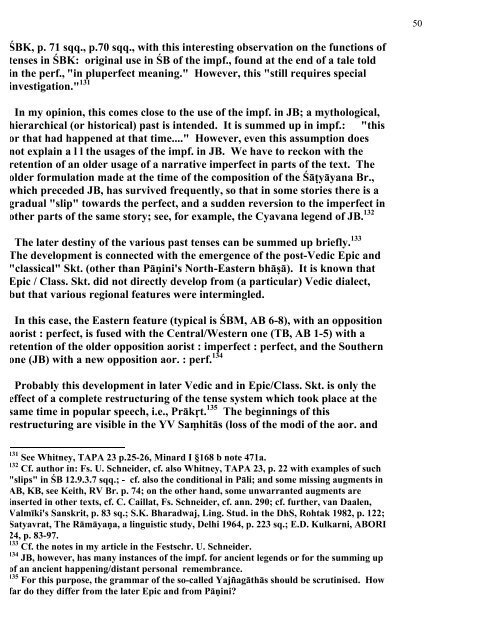TRACING VEDIC DIALECTS - People.fas.harvard.edu
TRACING VEDIC DIALECTS - People.fas.harvard.edu
TRACING VEDIC DIALECTS - People.fas.harvard.edu
Create successful ePaper yourself
Turn your PDF publications into a flip-book with our unique Google optimized e-Paper software.
ŚBK, p. 71 sqq., p.70 sqq., with this interesting observation on the functions of<br />
tenses in ŚBK: original use in ŚB of the impf., found at the end of a tale told<br />
in the perf., "in pluperfect meaning." However, this "still requires special<br />
investigation." 131<br />
In my opinion, this comes close to the use of the impf. in JB; a mythological,<br />
hierarchical (or historical) past is intended. It is summed up in impf.: "this<br />
or that had happened at that time...." However, even this assumption does<br />
not explain a l l the usages of the impf. in JB. We have to reckon with the<br />
retention of an older usage of a narrative imperfect in parts of the text. The<br />
older formulation made at the time of the composition of the Śāṭyāyana Br.,<br />
which preceded JB, has survived frequently, so that in some stories there is a<br />
gradual "slip" towards the perfect, and a sudden reversion to the imperfect in<br />
other parts of the same story; see, for example, the Cyavana legend of JB. 132<br />
The later destiny of the various past tenses can be summed up briefly. 133<br />
The development is connected with the emergence of the post-Vedic Epic and<br />
"classical" Skt. (other than Pāṇini's North-Eastern bhāṣā). It is known that<br />
Epic / Class. Skt. did not directly develop from (a particular) Vedic dialect,<br />
but that various regional features were intermingled.<br />
In this case, the Eastern feature (typical is ŚBM, AB 6-8), with an opposition<br />
aorist : perfect, is fused with the Central/Western one (TB, AB 1-5) with a<br />
retention of the older opposition aorist : imperfect : perfect, and the Southern<br />
one (JB) with a new opposition aor. : perf. 134<br />
Probably this development in later Vedic and in Epic/Class. Skt. is only the<br />
effect of a complete restructuring of the tense system which took place at the<br />
same time in popular speech, i.e., Prākṛt. 135 The beginnings of this<br />
restructuring are visible in the YV Saṃhitās (loss of the modi of the aor. and<br />
131 See Whitney, TAPA 23 p.25-26, Minard I §168 b note 471a.<br />
132 Cf. author in: Fs. U. Schneider, cf. also Whitney, TAPA 23, p. 22 with examples of such<br />
"slips" in ŚB 12.9.3.7 sqq.; - cf. also the conditional in Pāli; and some missing augments in<br />
AB, KB, see Keith, RV Br. p. 74; on the other hand, some unwarranted augments are<br />
inserted in other texts, cf. C. Caillat, Fs. Schneider, cf. ann. 290; cf. further, van Daalen,<br />
Valmīki's Sanskrit, p. 83 sq.; S.K. Bharadwaj, Ling. Stud. in the DhS, Rohtak 1982, p. 122;<br />
Satyavrat, The Rāmāyaṇa, a linguistic study, Delhi 1964, p. 223 sq.; E.D. Kulkarni, ABORI<br />
24, p. 83-97.<br />
133 Cf. the notes in my article in the Festschr. U. Schneider.<br />
134 JB, however, has many instances of the impf. for ancient legends or for the summing up<br />
of an ancient happening/distant personal remembrance.<br />
135 For this purpose, the grammar of the so-called Yajñagāthās should be scrutinised. How<br />
far do they differ from the later Epic and from Pāṇini?<br />
50
















